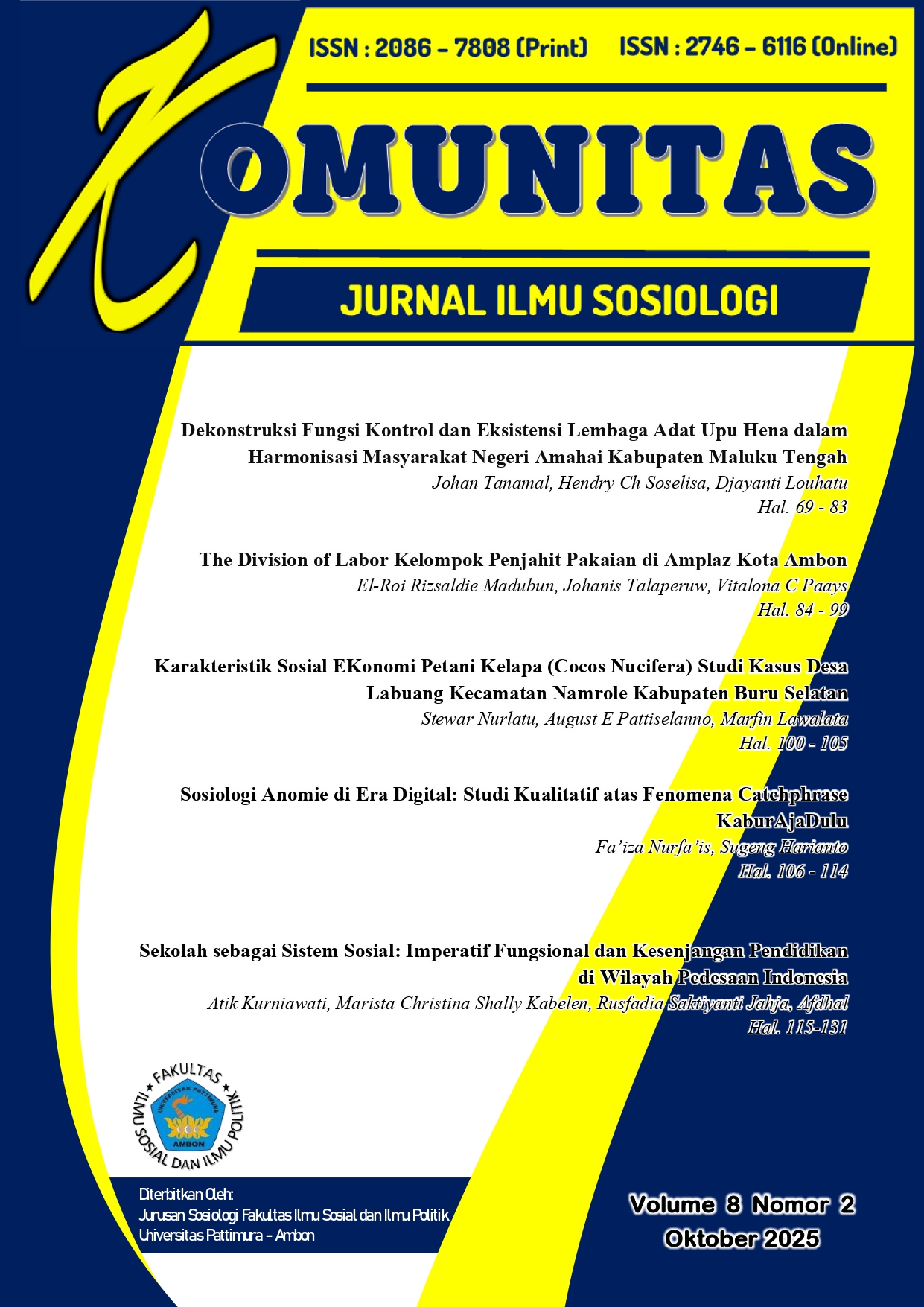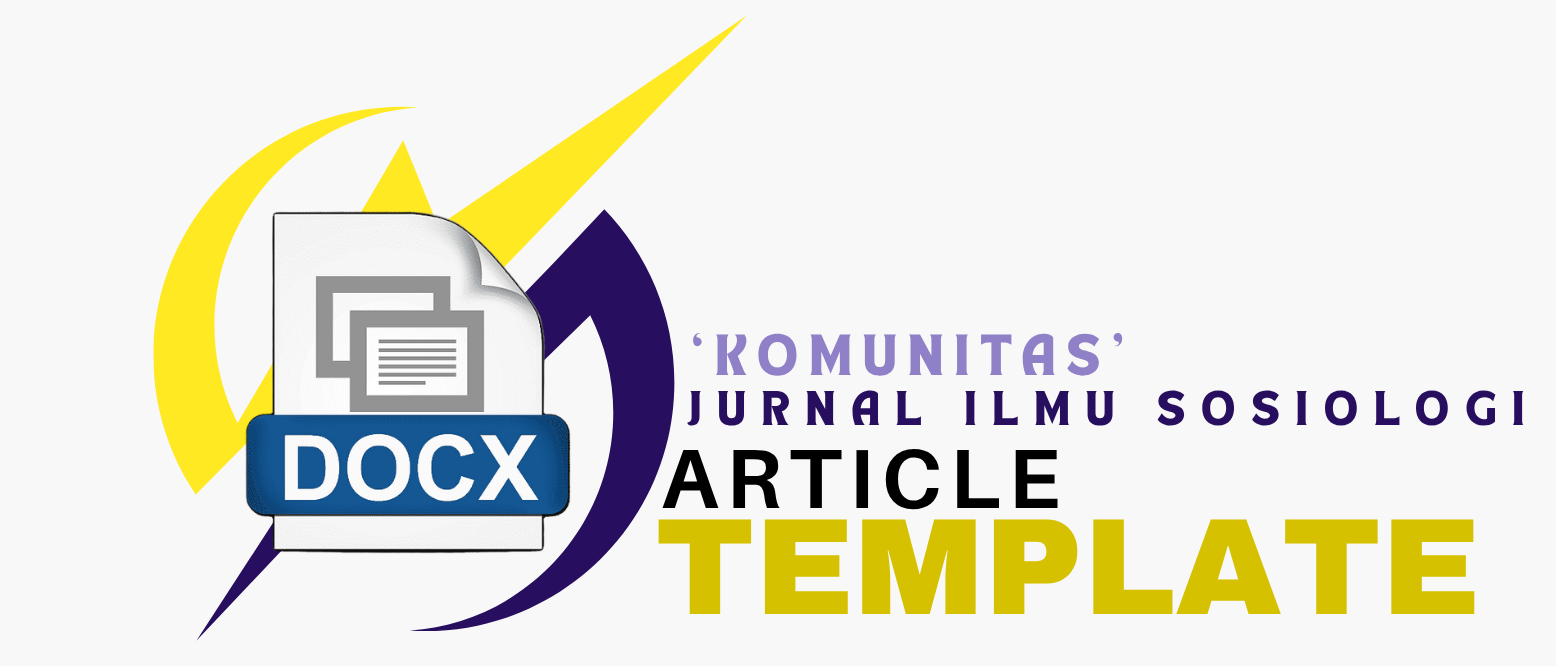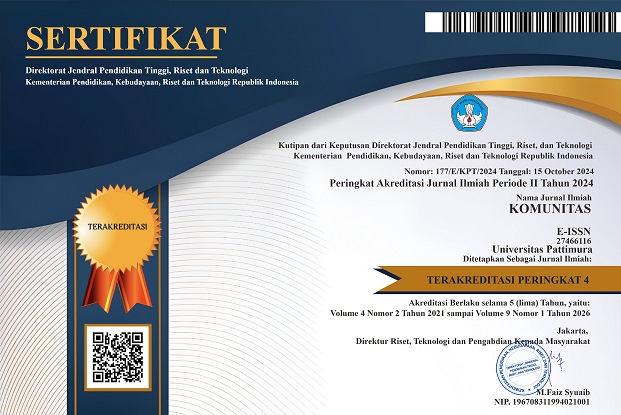Sekolah sebagai Sistem Sosial: Imperatif Fungsional dan Kesenjangan Pendidikan di Wilayah Pedesaan Indonesia
Abstract
Educational inequality in rural Indonesia reflects complex and layered structural issues. This study aims to analyze the social system functions of rural schools through Parsons’ AGIL framework (Adaptation, Goal attainment, Integration, Latency), examining how schools sustain and reproduce social structures. A qualitative case study was conducted at SMAN 13 in Tangerang Regency, representing rural schools near urban areas. Data were collected through in-depth interviews with 37 participants, participant observation, and document analysis between April and July 2025, followed by thematic analysis. The findings reveal the school’s adaptive role in responding to economic and resource limitations; goal attainment through transmitting mobility values, constrained by inadequate facilities and policies; integration through informal collaboration among schools, families, and communities; and cultural pattern maintenance via local and religious values that sometimes conflict with modernization. The study’s novelty lies in its empirical application of AGIL theory to rural schooling, offering theoretical contributions to educational sociology and providing a contextual basis for holistic policy development.
Downloads
References
Abfalter, D., Mueller-Seeger, J., & Raich, M. (2021). Translation decisions in qualitative research: a systematic framework. International Journal of Social Research Methodology, 24(4), 469–486. https://doi.org/10.1080/13645579.2020.1805549
Afdhal, A., Manuputty, F., Litaay, S. C. H., & Makaruku, N. D. (2024). Nilai-Nilai Kearifan Lokal Maluku dalam Hidden curriculum: Strategi Membangun Perdamaian dan Toleransi di Sekolah Dasar. Journal of Education Research, 5(4), 5071–5083. https://doi.org/10.37985/jer.v5i4.1707
Banaji, M. R., Fiske, S. T., & Massey, D. S. (2021). Systemic racism: individuals and interactions, institutions and society. Cognitive Research: Principles and Implications, 6(1), 82. https://doi.org/10.1186/s41235-021-00349-3
Creswell, J. W., & Poth, C. N. (2016). Qualitative inquiry and research design: Choosing among five approaches. Sage publications.
Ekaputri, R. A., Sukiyono, K., Yefriza, Y., Febriani, R. E., & Nopiah, R. (2025). Gendered Dimensions of Poverty in Indonesia: A Study of Financial Inclusion and the Influence of Female-Headed Households. Economies, 13(8), 240. https://doi.org/10.3390/economies13080240
Fadhil, I., & Sabic-El-Rayess, A. (2021). Providing Equity of Access to Higher Education in Indonesia: A Policy Evaluation. Indonesian Journal on Learning and Advanced Education (IJOLAE), 3(1), 57–75. https://doi.org/10.23917/ijolae.v3i1.10376
Faizah, C., Yamada, K., & Pratomo, D. S. (2021). Information and communication technology, inequality change and regional development in Indonesia. Journal of Socioeconomics and Development, 4(2), 224. https://doi.org/10.31328/jsed.v4i2.2669
Haidir, A. A., & Setyari, N. P. W. (2024). Indonesia social progress: the role of access to basic education in escaping from poverty trap. Jurnal Ekonomi & Studi Pembangunan, 24(2), 428–457. https://doi.org/10.18196/jesp.v24i2.19810
Hakim, D. R., & Rosini, I. (2022). Regional Income Inequality in Indonesia: The Role of Public and Private Investment. Jurnal Ekonomi Malaysia, 56(3), 87–101. https://doi.org/10.17576/JEM-2022-5603-05
Hasmawati, H., Winarti, W., Jumriani, J., Arfah, M. I. C., & Jafar, J. (2024). The Effect of Community-Based Entrepreneurship Development Programs on Improving the Economic Welfare of Communities in Rural Areas. Celebes Journal of Community Services, 3(2 SE-Articles), 10–23. https://doi.org/10.37531/celeb.v3i2.1618
Hill, H. (2021). What’s Happened to Poverty and Inequality in Indonesia over Half a Century? Asian Development Review, 38(1), 68–97. https://doi.org/10.1162/adev_a_00158
Khairunnisa, S., Haryani, D., Gusmiati, R., Putri, A. D. R., & Jolanis, J. (2025). The Influence of Education and Economic Growth on Income Inequality in Indonesia. International Journal of Environmental, Sustainability, and Social Science, 6(4), 859–866. https://doi.org/10.38142/ijesss.v6i4.1487
Lestaluhu, S. F., & Sopacua, Y. (2024). Disfungsi Transmisi Linguistik Intra-Keluarga: Hambatan Sosial dan Kultural dalam Pelestarian Bahasa Daerah Suku Wayoli di Tulehu, Maluku. Populis: Jurnal Ilmu Sosial Dan Ilmu Politik, 19(1), 79–94. https://doi.org/10.30598/populis.19.1.79-94
Lisnawaty, S. D. (2024). A Systematic Analysis of Literature Review Strategies for Implementing Out-of-School Education in Remote Areas. Jurnal Kajian Pendidikan Dan Psikologi, 1(3), 254–269. https://doi.org/10.61397/jkpp.v1i3.202
Litaay, S. C. H., Manuputty, F. M. L., Afdhal, A., & Makaruku, N. D. (2025). Local Culture-Based Education in the Hidden Curriculum: A Strategy for Fostering Tolerance and Peace in Maluku Secondary Schools. Society, 13(1), 192–207. https://doi.org/10.33019/society.v13i1.777
Marougkas, A., Troussas, C., Krouska, A., & Sgouropoulou, C. (2023). Virtual Reality in Education: A Review of Learning Theories, Approaches and Methodologies for the Last Decade. Electronics, 12(13), 2832. https://doi.org/10.3390/electronics12132832
Mujiburrohman, & Putri, D. (2024). The Impact of Social Inequality on Educational Quality in Indonesia: Challenges and Policy Recommendations. Solo Universal Journal of Islamic Education and Multiculturalism, 3(01), 43–56. https://doi.org/10.61455/sujiem.v3i01.248
Ninghardjanti, P., Murtini, W., Hindrayani, A., & Sangka, K. B. (2023). Evaluation of the Smart Indonesia Program as a Policy to Improve Equality in Education. Sustainability, 15(6), 5114. https://doi.org/10.3390/su15065114
Parsons, T. (1957). The Social System. Free Press.
Rafsanjani, T. A., & Rozaq, M. A. (2024). Educational Problems in Indonesia. Solo Universal Journal of Islamic Education and Multiculturalism, 2(02), 135–144. https://doi.org/10.61455/sujiem.v2i02.197
Romlah, S., Imron, A., Maisyaroh, Sunandar, A., & Dami, Z. A. (2023). A free education policy in Indonesia for equitable access and improvement of the quality of learning. Cogent Education, 10(2), 2245734. https://doi.org/10.1080/2331186X.2023.2245734
Setyadharma, A., Oktavilia, S., Utami, S., & Rizka Noormalitasari, A. (2021). Impacts of Education and Environmental Sustainability on Rural Income Inequality in Indonesia. E3S Web of Conferences, 232(12), 04003. https://doi.org/10.1051/e3sconf/202123204003
Vindrola-Padros, C., & Johnson, G. A. (2020). Rapid Techniques in Qualitative Research: A Critical Review of the Literature. Qualitative Health Research, 30(10), 1596–1604. https://doi.org/10.1177/1049732320921835
Welch, A., & Aziz, E. A. (2022). Higher Education in Indonesia. In International Handbook on Education in South East Asia (pp. 1–30). https://doi.org/10.1007/978-981-16-8136-3_41-1
Wirandana, P. A., & Khoirunurrofik, K. (2024). Educational inequality in Indonesia: are intergovernmental fiscal transfers effective in reducing the gap? Educational Studies, 50(6), 1424–1443. https://doi.org/10.1080/03055698.2022.2103647
Copyright (c) 2025 Atik Kurniawati, Marista Christina Shally Kabelen, Rusfadia Saktiyanti Jahja, Afdhal Afdhal

This work is licensed under a Creative Commons Attribution-NonCommercial-ShareAlike 4.0 International License.


2.png)










.png)

